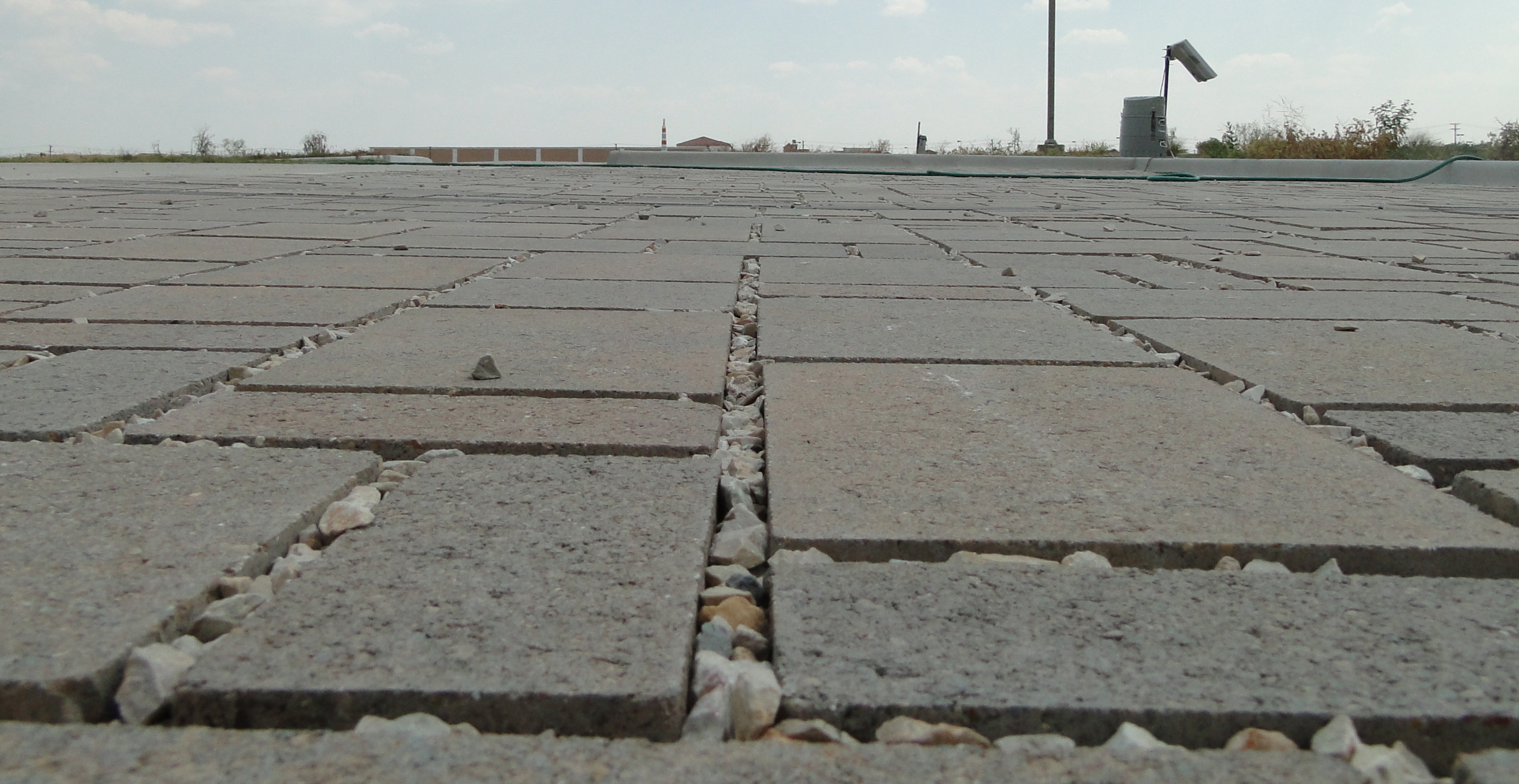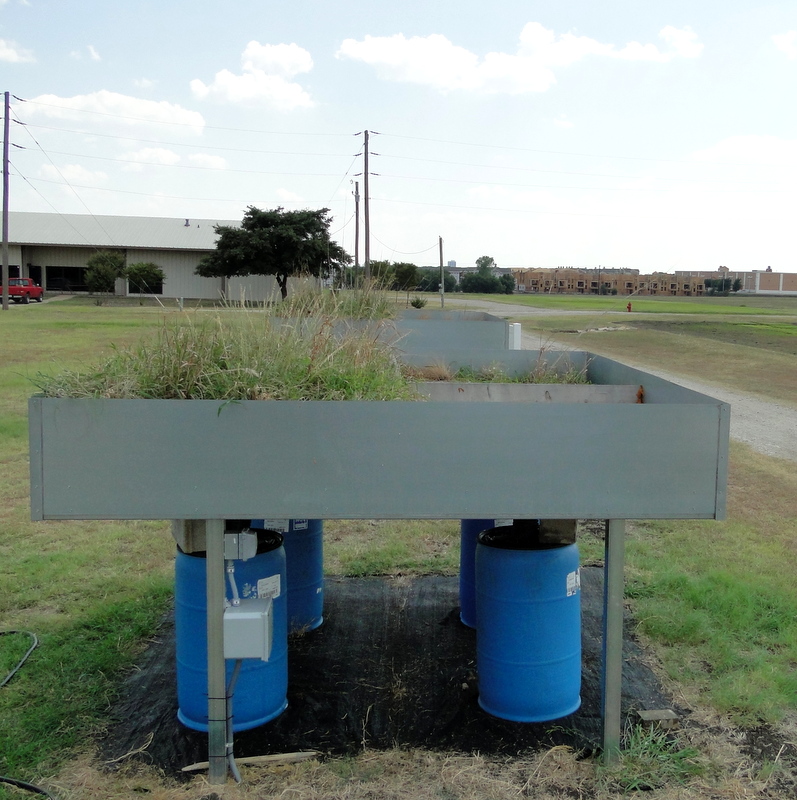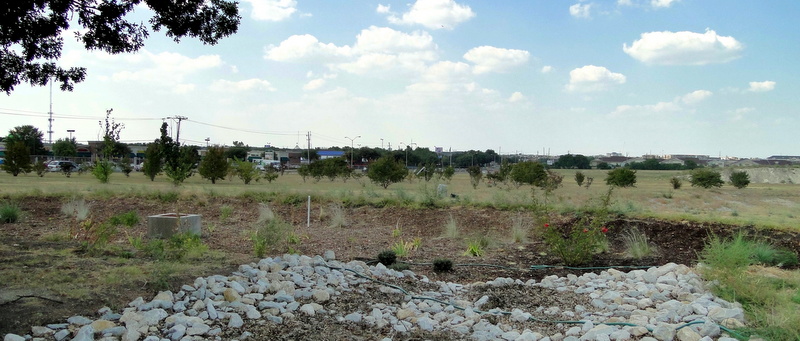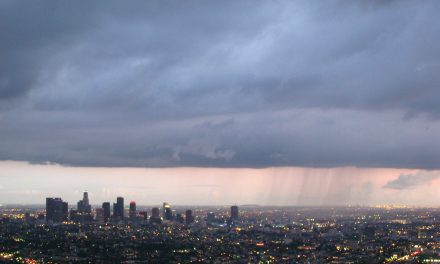By Kristina Twigg, Stormwater Report editor
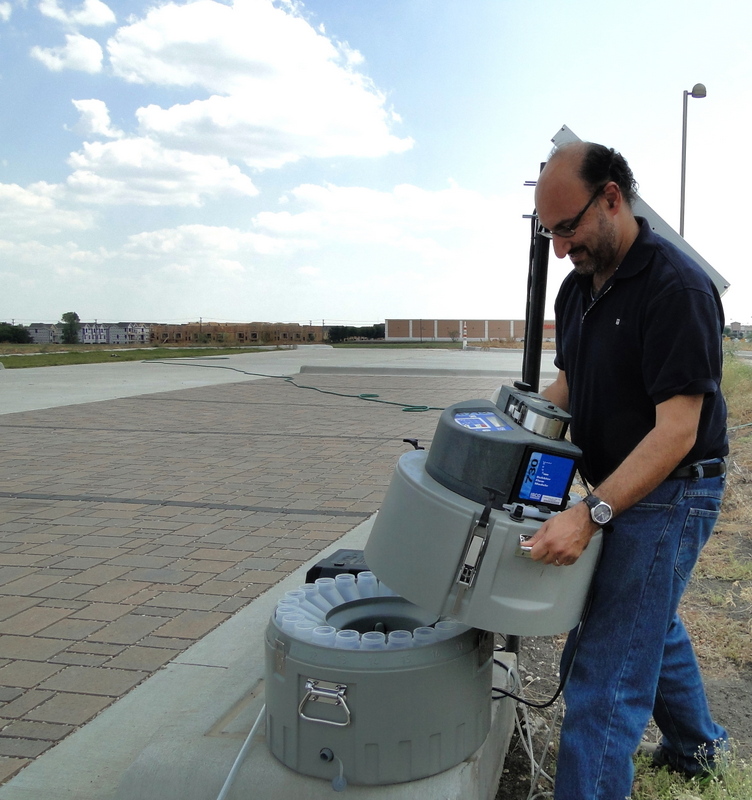
AgriLife Extension specialist Fouad Jaber displays the device used to measure and sample water quantity and quality parameters on several of the center’s low impact development facilities.
I recently took a trip to my home state and visited the Texas A&M AgriLife Research & Extension Center at Dallas, where I interned in 2009. While there, AgriLife Extension specialist Fouad Jaber provided a tour of the center’s recently implemented low impact development (LID) facilities.
According to Jaber, the center was one of the first LID projects in Texas to receive funding from a Clean Water Act Sec. 319 grant.
The center is developing quantitative data on the performance of rainwater harvesting, bioretention, detention, green roofs, and permeable pavement systems in the southern U.S. Researchers are studying both runoff reduction and water quality, particularly as related to bacteria and chlordane, a man-made pesticide that is a mixture of more than 50 chemicals.
Chlordane impairment
The Upper Trinity River watershed’s chlordane-impaired status led to the center’s grant through the Texas Commission on Environmental Quality. Many LID practices can successfully reduce total suspended solids (TSS), effectively decreasing such soil-bound pollutants as chlordane.
This legacy pollutant, originally used on crops and home foundations, was banned in 1983. However, cities within the Dallas–Fort Worth metroplex continue to undergo rapid growth, and sediment pollution from construction and building contributed heavily to the Trinity River’s chlordane impairment. Further, chlordane bioaccumulates in animals and was found in the tissue of Trinity River fish.
“Concentrations peaked in 2008 and are now decreasing, which is natural,” Jaber said. But now, the North Central Texas Council of Governments is working on a total maximum daily load targeting bacteria in the Upper Trinity River. The center’s grant has been extended 1 year for further monitoring, which now includes bacteria, as well as TSS, nitrate, total nitrogen, ammonia, total phosphorus, and orthophosphate.
LID knowledge in demand
The LID systems came on-line in November 2012 after a planning, design, and construction period of 2.5 years. Since then, the center has seen large reductions in runoff volume in most systems, which has also reduced pollutant loading, compared to control systems.
The center worked with an engineering company to create official designs for most of the practices. According to Jaber, the most difficult part of the process was finding contractors to install LID and controlling the cost of construction. Despite cutting the project requirements nearly in half, costs remained high. “There is a lack of LID knowledge in the construction community,” Jaber said. “They considered these projects specialized and charged more.” While all of the pervious pavers were donated, the center is still looking for contractors to install the pervious asphalt.
“We need to increase LID experience among contractors if it is going to be in demand,” Jaber said.
North Texas recently hosted an LID design competition. “The competition generated a lot of buzz,” Jaber said. “Many firms participated, and now LID is being implemented in many areas.” For instance, the Fort Worth School District plans to use LID on school grounds, and the City of Fort Worth service center will likely highlight LID, he said. Jaber participated on the winning team for the North Texas LID Design Competition’s mixed-use redevelopment project at Cedar’s West. Since then, people have been turning to him for general advice on local LID projects.
The center’s five LID components
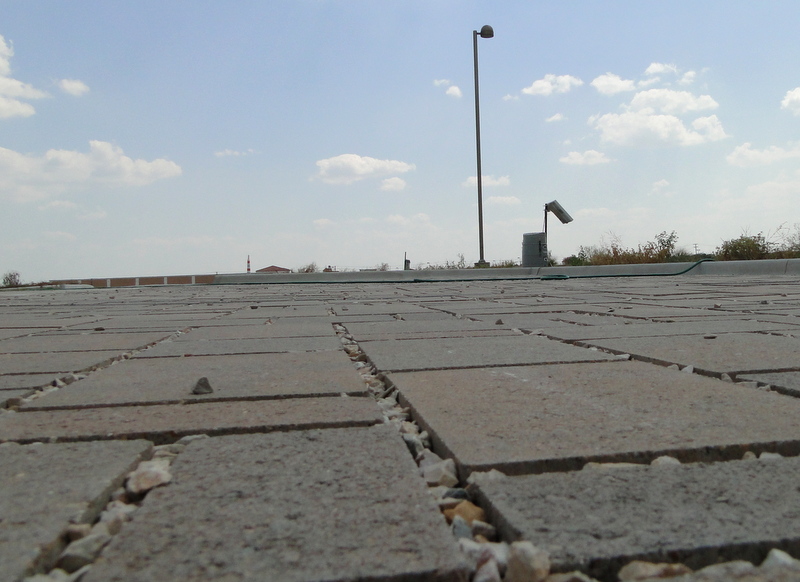
The Texas A&M AgriLife Research & Extension Center at Dallas is testing five parking surfaces. Interlocking concrete blocks are pictured here.
Permeable parking
The first stop on the LID tour was the 54-space parking lot where researchers are comparing five surfaces side-by-side: pervious and impervious concrete, interlocking concrete blocks, pervious asphalt, and grass blocks.
The grass paver utilizes expanded shale, which looks like small, lightweight grey lava rocks. It is, in fact, fired clay that holds water and serves as a base for the grass paver. It is currently being used in overflow parking at Cowboy’s Stadium.
Runoff travels through about 15 cm (6 in.) of paver and another 20 cm (8 in.) of gravel. In the black-land prairie, where clay soils create low-infiltration and shrink-swell conditions, the gravel helps prevent soil movement from affecting the pavers.
A bubbler flowmeter, shown in the first image, makes it easy to collect flow and volume data from the permeable pavement, rain garden, and detention pond. Bubbler refers to the device that measures the level of water in the flow stream. The machine uses this value to calculate the flow rate. The device also takes water quality samples automatically at assigned intervals. In the future, this will enable researchers to match water quality data with a hydrograph.
Green roofs
Next, we visited the green roofs. This portion is the only replicated LID study at the center, and researchers are examining the effects of drainage layers and soil mixes.
The four 9-m2 (100-ft2) test roofs are divided into four compartments: a control with no soil or plants; compartments with and without a drainage layer; a proprietary, sterilized soil medium; and the center’s mix of one-third compost, one-third expanded shale, and one-third native soil. The plants seemed to be struggling in the proprietary soil, while both weeds and native plants are growing in the center’s soil mix.
Four rain barrels capture water that infiltrates each of the individual green-roof compartments, as well as water that overflows the roof. Researchers can test the water level every 5 minutes during a storm event and collect water samples for testing.
For the green-roof and rainwater-harvesting systems, center researchers built their own monitoring system. Using these systems, they can determine the outflow hydrograph via a rain gauge that serves as a flowmeter, and they collect water samples by hand after each storm. The sample data enables researchers to determine whether the green roofs improve water quality or actually begin to export pollutants to the water over time.
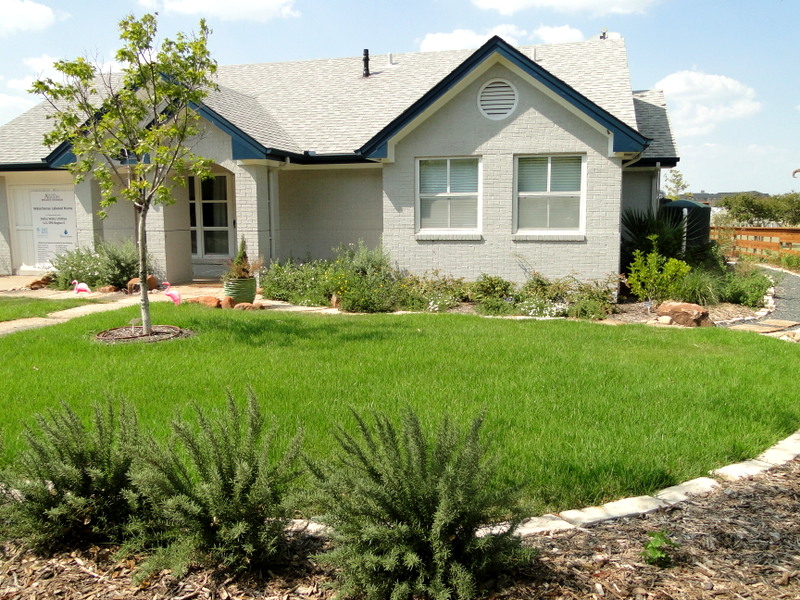
In addition to research, the Texas A&M AgriLife Research & Extension Center at Dallas also outreaches to area residents on ways to reduce stormwater pollution and conserve water. Pictured here is the WaterSense Labeled Home complete with a rainwater harvesting system.
Rainwater harvesting
Next, we visited the rainwater-harvesting study, where researchers are measuring the water balance between stormwater and water use. Four miniature roofs with four miniature lawns stood next to one another, each representing a 1:10 ratio with the typical North Texas suburban home.
Each roof’s runoff is captured by three 208-L (55-gal) rain barrels and used to irrigate the miniature lawns at various levels. One lawn’s irrigation system utilizes a soil-moisture system, while another is based on evapotranspiration. In these two systems, the need for city water is reduced by 90%, while runoff is decreased by about 40% to 50%. In these two scenarios, water accumulates in the rain barrels during winter, when irrigation demand is very low, so some water is wasted. The next lawn is on a home watering schedule, which leads to overwatering, Jaber said. In this scenario, runoff is decreased by 60% — “The barrel is always empty, so there is more room for rain,” Jaber said. “Of course, you could simply empty the barrels in the first two scenarios, based on predicted rainfall.”
The basis for comparison is a control with no harvesting that relies on city water and a home watering schedule for irrigation. Runoff from the lawn and roof overflow is collected at the edge of each yard. The flow is measured, and a portion is stored for sampling.
Rain garden
The center also has a rain garden designed to manage a 38-mm (1.5-in.) storm. It sits at a natural low point on the property, where runoff from its 2044-m2 (22,000-ft2) parking lot rushes into the garden’s forebay. The forebay reduces the water’s velocity and its sediment load, helping maintain the rain garden’s ability to infiltrate stormwater. Water infiltrates 1 m (3 ft) of compost, expanded shale, and native soil and is taken up by native plants. With a perforated pipe and corrugated overflow pipe, the rain garden’s underdrain is also designed to remove nutrients by utilizing both aerobic and anaerobic processes.
Sustainable detention pond
The center’s sustainable detention pond captures overflow from the rain garden, as well as 4.25 ha (10.5 ac) of center property. Detention ponds are generally considered traditional stormwater infrastructure and have certain limitations. They have limited ability to provide water quality treatment and no ability to address excess stormwater volume. Instead, detention ponds traditionally mitigate peak flow, retaining water but still discharging it over time. In contrast, the detention pond at the Texas A&M AgriLife Research & Extension Center at Dallas is planted with native plants and meanders like a river, increasing the effective drainage area. The meanders also improve infiltration and provide more time for sediments to settle and for plant uptake.
“The detention pond was built like a rain garden,” Jaber said. However, it holds much more water than a typical bioretention facility. The pond has two inlets emptying into two channels — one that can hold 1.2 m (4 ft) of water and another that is 3.7 m (12 ft) deep in some areas. Native plants growing along the bank help to take up water and create a natural environment that discourages mosquitos. The underlying soil of the pond was not modified because it is calcareous with a higher infiltration rate than the clay topsoil.
“Basically, this pond is comparable to a wet pond design, which stays wet all year long, but instead it infiltrates the water over a period up to two weeks,” Jaber said. However, infiltration would only take this long during the design storm of 38 mm (1.5 in.) of rainfall, which happens about 2-3 times per year in Dallas.
The water depth is measured and samples are taken at the outflow. However, “since December, we haven’t had any outflow,” Jaber said. “We have captured all of the runoff leaving our property.”

Unlike a typical detention pond, this one is intended to infiltrate water. It meanders like a river, and its banks have been seeded with native plants.
[hr]
Data from the Texas A&M AgriLife Research & Extension Center at Dallas will help inform North Texas efforts to implement LID and protect the Trinity River. In addition, students are using the center’s data to model the effects of LID on a city scale in Austin and to develop a set of recommendations that optimize treatment costs for city officials in Houston. For another look at the center’s research, check out the video below.

